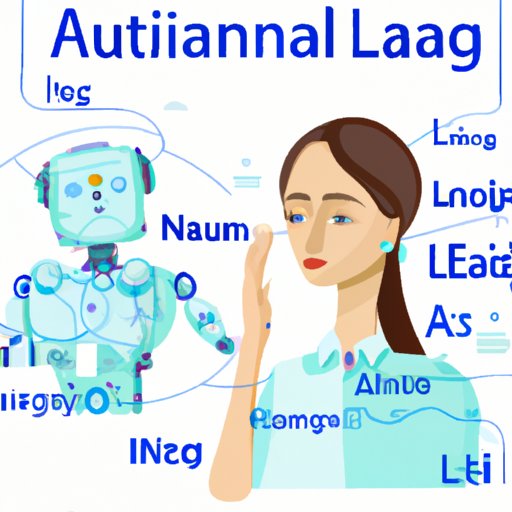Introduction
Natural language processing (NLP) is an essential part of artificial intelligence (AI), as it allows computers to understand, interpret, and manipulate human languages. NLP is one of the most important technologies used in AI applications, and is a key factor in the development of intelligent systems. In this article, we explore what NLP is and how it is being used to revolutionize AI. We also look into the benefits and challenges of utilizing NLP for smart automation in AI applications.
Exploring Natural Language Processing in AI
NLP is a field of computer science that focuses on enabling machines to understand and process natural language. It is concerned with the interaction between computers and human language, and involves the use of algorithms and machine learning techniques to enable computers to understand, analyze, and generate natural language. NLP enables computers to interact with humans in a more natural way, allowing them to communicate and understand written or spoken language.
To understand how NLP works, we must first look at the components of natural language. Natural language can be broken down into three main components: syntax, semantics, and pragmatics. Syntax refers to the structure of language, including grammar and word order. Semantics deals with the meaning of words and sentences. Pragmatics is concerned with the use of language in context, such as the speaker’s intention and the situation in which the language is used. NLP uses these components to enable computers to understand and process natural language.
NLP has many applications in AI. It is used in natural language understanding (NLU), which involves extracting meaning from text and speech. It is also used in natural language generation (NLG), which enables computers to generate natural language based on input data. NLP is used in machine translation, which enables computers to automatically translate text from one language to another. Finally, NLP is used in dialogue systems, which allow computers to interact with humans in a natural way.

How NLP is Revolutionizing AI
NLP is revolutionizing AI by enabling computers to interact more naturally with humans. By leveraging NLP, AI systems are able to automate tasks, improve decision-making, and enable automated reasoning and problem solving. This is allowing AI systems to become smarter and more capable than ever before.
One of the major benefits of NLP is that it enables the automation of tedious tasks. For example, NLP can be used to automate customer service inquiries, such as responding to emails or answering frequently asked questions. NLP can also be used to detect patterns in data, such as identifying suspicious activity or uncovering insights from large datasets. This enables AI systems to automate mundane tasks, freeing up time for employees to focus on more important tasks.
Another benefit of NLP is that it enables automated reasoning and problem solving. AI systems can use NLP to identify relationships between different pieces of information, allowing them to make decisions and solve problems. For example, AI systems can use NLP to identify correlations between different variables, such as customer preferences and product sales. This enables AI systems to make more accurate predictions and better decisions.
Finally, NLP is improving decision-making by allowing AI systems to understand the context of conversations. NLP enables AI systems to understand the intent behind a conversation, allowing them to respond in an appropriate manner. This is allowing AI systems to provide more personalized experiences, as they can understand the nuances of language and tailor their responses accordingly.

Utilizing NLP for Smart Automation in AI
NLP is an essential tool for smart automation in AI applications. In order to utilize NLP for smart automation, organizations must first implement NLP in their AI applications. This requires understanding the underlying technology and developing algorithms that can extract and understand the meaning of natural language. Organizations must also develop NLP applications that can be integrated into existing AI systems, such as chatbots or virtual assistants.
Once NLP applications have been developed, organizations must then adopt NLP in their business solutions. This involves integrating NLP applications into existing software, such as customer service platforms or data analytics tools. Organizations must also ensure that their NLP applications are properly trained and optimized for maximum accuracy. This will enable AI systems to accurately interpret and respond to natural language, allowing for more efficient and effective automation.
Conclusion
NLP is an essential component of AI, as it enables computers to understand and process natural language. It is revolutionizing AI by enabling automated tasks, improved decision-making, and automated reasoning and problem solving. NLP is also allowing organizations to utilize smart automation in their AI applications, by implementing NLP in their applications, developing NLP applications, and adopting NLP in their business solutions.
While there are many benefits to using NLP in AI, there are also some challenges. Developing NLP applications can be difficult and time consuming, and requires a deep understanding of the underlying technology. Additionally, organizations must ensure that their NLP applications are properly trained and optimized for maximum accuracy. Despite these challenges, NLP is an essential tool for improving AI and enabling more efficient and effective automation.
(Note: Is this article not meeting your expectations? Do you have knowledge or insights to share? Unlock new opportunities and expand your reach by joining our authors team. Click Registration to join us and share your expertise with our readers.)
